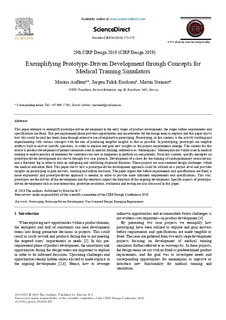| dc.contributor.author | Auflem, Marius | |
| dc.contributor.author | Erichsen, Jorgen Falck | |
| dc.contributor.author | Steinert, Martin | |
| dc.date.accessioned | 2019-09-10T06:33:45Z | |
| dc.date.available | 2019-09-10T06:33:45Z | |
| dc.date.created | 2019-09-09T09:22:42Z | |
| dc.date.issued | 2019 | |
| dc.identifier.citation | Procedia CIRP. 2019, 84 572-578. | nb_NO |
| dc.identifier.issn | 2212-8271 | |
| dc.identifier.uri | http://hdl.handle.net/11250/2614367 | |
| dc.description.abstract | This paper attempts to exemplify prototype-driven development in the early stages of product development, the stages before requirements and specifications are fixed. This pre-requirement phase provides opportunities and uncertainties for the design team to explore, and this paper shows how this could be (and has been) done through extensive use of explorative prototyping. Prototyping, in this context, is the activity building and experimenting with various concepts with the aim of producing tangible insights as fast as possible. In prototyping, prototypes are tangible artifacts built to answer specific questions, in order to explore and gain new insights as the project requirements emerge. The context for this article is product development of patient simulators used in medical training, referred to as ‘Mannequins’. Mannequins are widely used in medical training to enable practice of treatment for conditions too rare or dangerous to perform on real patients. From this context, specific examples on prototype-driven development are shown through two case projects; Development of a chest for the training of cardiopulmonary resuscitation, and a fractured leg in order to train on realigning and stabilizing displaced fractures. These projects are user-centered design challenges within the medical education field. This paper shows how a prototype-driven development approach could be utilized on a project level and provides insights on prototyping to gain answers, learning and inform decisions. The paper argues that before requirements and specifications are fixed, a more exploratory and prototype-driven approach is needed, in order to provide more informed requirements and specifications. This way, prototypes are the drivers of the development and the iterations impact the direction of the ongoing development. Specific aspects of prototype-driven development such as user-interaction, prototype resolution, evaluation and testing are also discussed in this paper. | nb_NO |
| dc.language.iso | eng | nb_NO |
| dc.publisher | Elsevier | nb_NO |
| dc.rights | Attribution-NonCommercial-NoDerivatives 4.0 Internasjonal | * |
| dc.rights.uri | http://creativecommons.org/licenses/by-nc-nd/4.0/deed.no | * |
| dc.title | Exemplifying Prototype-Driven Development through Concepts for Medical Training Simulators | nb_NO |
| dc.type | Journal article | nb_NO |
| dc.type | Peer reviewed | nb_NO |
| dc.description.version | publishedVersion | nb_NO |
| dc.source.pagenumber | 572-578 | nb_NO |
| dc.source.volume | 84 | nb_NO |
| dc.source.journal | Procedia CIRP | nb_NO |
| dc.identifier.doi | https://doi.org/10.1016/j.procir.2019.04.202 | |
| dc.identifier.cristin | 1722654 | |
| dc.description.localcode | © 2019 The Author(s). Published by Elsevier B.V. This is an open access article under the CC BY-NC-ND 4.0 license. | nb_NO |
| cristin.unitcode | 194,64,92,0 | |
| cristin.unitname | Institutt for maskinteknikk og produksjon | |
| cristin.ispublished | true | |
| cristin.fulltext | original | |
| cristin.qualitycode | 1 | |

